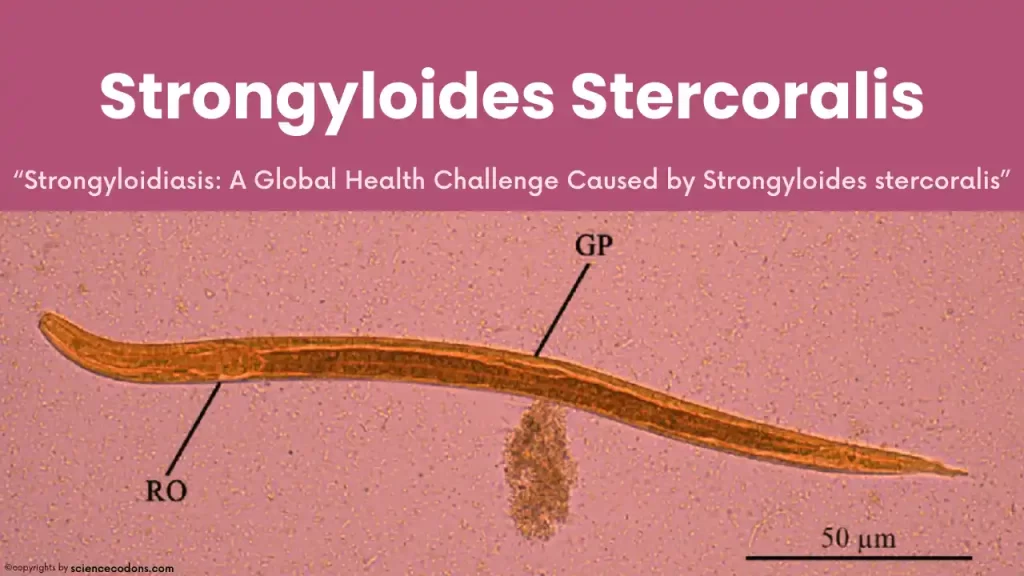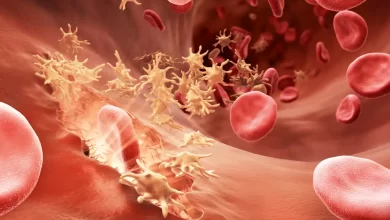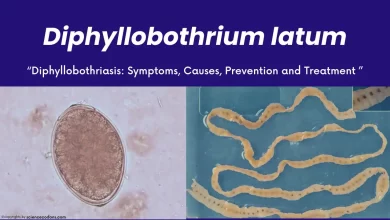
Strongyloides stercoralis, also known as Anguillula stercolaris and Strongyloides intestinalis, is the smallest human digestive nematode. This parasite can cause skin, respiratory, and digestive diseases due to its unique life cycle. This worm is prevalent in tropical and subtropical regions. It is estimated that between 30 and 100 million people worldwide are infected.
What is Strongyloides stercoralis? [Characteristics]
Strongyloides Stercoralis is the smallest human digestive nematode. This worm typically resides in the human small intestine and can grow up to 2.5 millimeters in size. It was first identified in the diarrheal feces of French soldiers returning from Indonesia. The life cycle of this worm was discovered by Fullebarn in 1926. Later, Faust and his colleagues reported a phenomenon called autoinfection in the worm’s life cycle.
The worm has only three lips on its head, and one-third of its body length is the esophagus. Male worms are seldom seen, leading to the belief that female worms reproduce through a process called parthenogenesis or virgin birth to fertilize their eggs.
The eggs are 54×32 microns in size and resemble those of hookworms. However, there are differences, such as their growth stage, which occurs more than hookworms. The blastomeric stage transforms into the Morella stage, typically containing 16-32 cell masses. The larvae can exit the egg in the intestinal mucosa.
- Parthenogenesis is a process where the female sex reproduces without the presence of the male sex.
Lifecycle: A Journey Through the Soil and Body
Strongyloides Stercoralis, among all worms, has the most diverse life cycle. It undergoes three life cycles: free-living, parasitic, and autoinfection.
Autoinfection Life Cycle
This worm resides in the human digestive system, specifically the small intestine. Here, the male and female mate, or in rare cases where the male is absent, the female performs parthenogenesis. The eggs of Strongyloides Stercoralis are then excreted. In the morula stage, these eggs mature after some time outside the body. If the host has a weak immune system or suffers from constipation, the eggs mature and hatch inside the intestine, releasing the larvae. These larvae enter the intestinal blood flow and undergo a heart-lung cycle. They ascend from the lungs, descend from the esophagus, and return to the intestine. This cycle completes within 3-4 weeks, and the larvae metamorphose into adult worms. This type of cycle typically occurs in AIDS patients or those with severe constipation.
Parasitic Life Cycle
This cycle occurs when the eggs are excreted outside the body while the external conditions are unfavorable for the larvae. The filarial form of the larvae usually forms within 2-3 days and enters the human body through the skin. They undergo a heart-lung cycle, return to the digestive system, and mature within 3-4 weeks. Mating occurs, and the eggs are excreted again.
Free-living Life Cycle
When favorable environmental conditions, the excreted eggs usually become larvae, and the rhabditiform larvae emerge. Within one or two days, these rhabditiform larvae metamorphose into adult worms and mate with each other outside the body. The female worms start laying eggs and live freely without needing a human host.
Symptoms of strongyloidiasis
The signs that Strongyloides Stercoralis infection creates vary depending on the organ involved. The first part involved is the skin, which is due to the invasion of larvae and their migration under the skin. This sign is a red skin rash and itching that creates a creeping lesion (this complication also occurs in cutaneous migratory larvae).
The next organs are the lungs, which are involved due to the heart-lung migration that the larvae of Strongyloides Stercoralis have. At this stage, respiratory symptoms such as pneumonia, shortness of breath, chest pain, and hemoptysis may be seen.
The next organ is the digestive system, which has digestive symptoms such as nausea, stomach pain, diarrhea, constipation, dysentery, and in the form of autoinfection severe infection in AIDS patients or those with a weak immune system or severe constipation is seen and may cause hepatitis, temporary bowel paralysis (ileus), gallbladder inflammation, myocarditis, shortness of breath, spinal cord injury (myelitis), nephritis to the kidneys and generally the patient suffers from weight loss and mild anemia. Blood loss causes the loss of blood elements, such as iron swelling of the hands and feet and ascites.
| Symptom | Description |
|---|---|
| Raised, red, itchy rash (larva currens) | Often between your butt cheeks, on your thighs, or on your wrists. |
| Nausea | Feeling of queasiness or an urge to vomit. |
| Diarrhea | Frequent, loose, watery bowel movements. |
| Upper abdominal pain | Similar to heartburn or an ulcer. |
| Bloating | Feeling of fullness or discomfort due to gas or fluid accumulation. |
| Cough or scratchy throat | Less common, but may occur. |
How can Strongyloides Stercoralis be prevented?
Preventing Strongyloides stercoralis infection involves avoiding or reducing exposure to contaminated soil or water containing the larvae. The prevention measures include:
- Wearing protective clothing, such as gloves, boots, and long pants, when working or playing in soil or water that may be contaminated with human or animal feces.
- Washing hands and feet with soap and water after contact with soil or water that may be contaminated with human or animal feces.
- Washing and peeling raw vegetables and fruits or cooking them thoroughly before eating them, especially if they have been in contact with soil or water that may be contaminated with human or animal feces.
- Boiling or filtering drinking water or using bottled water, especially if the water source is suspected to be contaminated with human or animal feces.
- Controlling the infection in animals by preventing them from eating raw
Note: Prevention mechanisms are similar to those for hookworms, including maintaining hygiene, wearing boots, properly disposing of human sewage to prevent it from entering bodies of water, and treating the disease.
How to Diagnose and Treat Strongyloidiasis?
The diagnosis of Strongyloides stercoralis is typically made using a stool test. As previously mentioned, the eggs of this worm are excreted in the morula stage. The morula is a stage that precedes the larval stage, and most often, larvae form within the egg. In a stool test, in addition to the eggs, the larvae can also be observed. Stool culture methods such as the Baermann and Harada-Mori techniques can be used, allowing the complete transformation from egg to larva and making the larvae visible. Molecular methods like PCR and duodenal intubation, where the contents of the duodenum are aspirated, can also be used for diagnosis. Additionally, high eosinophilia in some patients can assist in diagnosis.
Treatment of Strongyloides Stercoralis can be achieved through one of the following medications, which should be administered under the supervision of a doctor and after a confirmed diagnosis:
- Albendazole: Administered at a dosage of 400 milligrams daily for 3-4 days.
- Thiabendazole: Administered at a dosage of 25mg/kg, twice a day for 3 days.
- Mebendazole: Administered at a dosage of 100mg/kg, twice a day for 3-4 days.
- Ivermectin: Administered at a dosage of 200mg/kg daily for 3 days
Conclusion
Strongyloides stercoralis is a type of roundworm that can infect humans and animals by penetrating their skin and migrating to their intestines. It can cause a disease called strongyloidiasis, ranging from mild to life-threatening, depending on the host’s immune status. The infection can be diagnosed by stool examination, serology, or molecular tests and treated with anthelmintic and immunosuppressive drugs. The infection can be prevented by avoiding or reducing the exposure to contaminated soil or water that contains the larvae. Strongyloides stercoralis is a severe and neglected parasitic disease that requires more awareness and research to improve its diagnosis, treatment, and prevention.
Reference:
- https://doi.org/10.1186/s13071-020-041150-0
- https://doi.org/10.1371/journal.pntd.0007609
- Impact of global health residency training on medical knowledge of immigrant health – PubMed (nih.gov)
- cell.com/current-biology/pdf/S0960-9822(18)30699-7.pdf
- Red Book Atlas of Pediatric Infectious Diseases
- CDC













